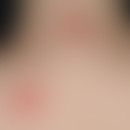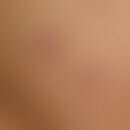Synonym(s)
HistoryThis section has been translated automatically.
DefinitionThis section has been translated automatically.
Acute, usually infection-related (frequently streptococcal infections), self-limiting panniculitis associated with general symptoms such as fever and arthralgias as well as subcutaneous, painful nodules (predominantly) on the extensor sides of the lower legs.
You might also be interested in
Occurrence/EpidemiologyThis section has been translated automatically.
Panethnic. Most common septal panniculitis. Prevalence in Central Europe: 100-200/100.000 inhabitants/year. Incidence in Central Europe: 2-8/100,000 inhabitants/year.
EtiopathogenesisThis section has been translated automatically.
In a larger proportion of cases (30-50%), it is not possible to assign an exact triggering cause. In addition to these "idiopathic" cases, infectious and/or drug-allergic causes or combinations of these can be proven. The spectrum of triggering infections is very different in the various regions of the world. The spectrum of triggering infections is very different in the various regions of the world.
- The underlying immune mechanisms are not clearly defined; the formation of so-called Miescher's radial nodules in the fatty tissue septa suggests a panniculitis primarily occurring in the septal connective tissue.
- Erythema nodosum occurs in:
- Rheumatic fever
- tuberculosis
- sarcoidosis
- regional enteritis
- ulcerative colitis
- Sweet syndrome
- pregnancy
- Contraceptives (progestogen component?)
- Takayasu arteritis (in approx. 10% of patients with TA)
- Behcet's disease (in approx. 80% of cases, recurrent)
- Furthermore "infectious allergic" in:
- Streptococcal infections (frequent cause!)
- Hepatitis B virus infections
- Cat scratch disease
- Salmonella enteritis
- Lymphogranuloma inguinale
- Coccidioidomycosis
- Lymphogranuloma inguinale
- Ornithosis
- Yersinia infections
- Infectious mononucleosis
- toxoplasmosis
- deep mycoses.
ManifestationThis section has been translated automatically.
Mostly occurring in adults between the ages of 20-40. Also occurring in children and adolescents. Usually symmetrical, described unilaterally in rare cases.
f:m=3-6:1
Seasonally clustered in spring and autumn.
LocalizationThis section has been translated automatically.
ClinicThis section has been translated automatically.
Beginning with general symptoms such as fever, fatigue, tiredness, rheumatoid pain as well as symmetrically and bilaterally arranged, light or bright red, blurred, 2.0-10.0 cm in size, pressure pain, sometimes extremely pressure pain (so that even light touching is felt as unpleasant), doughy, slightly raised, reddish-livid lumps or plaques with a smooth, taut surface. The skin changes can confluent to larger (up to 5-15 cm) areas. The nodules never ulcerate. The single foci heal within 3-6 weeks with a change of colour (from reddish-brown to reddish-brown to brown-yellow and a slight grey-yellow) without scarring. In the eruption phase fresh spurts can occur.
Rare is a migratory centrifugal expansion of the foci, an activity state also known as subacute migratory panniculitis (panniculitis subacuta nodularis migrans) or erythema nodosum migrans.
LaboratoryThis section has been translated automatically.
HistologyThis section has been translated automatically.
Initial: infiltration by neutrophil granulocytes in the adipose tissue septum, formation of Miescher's radial nodules; edema, macrophages, foam cells.
Full-stage: granulomatous reaction of the adipose tissue; non-specific concomitant reaction in the reticular dermis; adipose tissue septums are fibrotically transformed.
Differential diagnosisThis section has been translated automatically.
Erythema induratum: chronic persistent, infectious allergic lobular panniculitis combined with vasculitis of the small vessels of the fat lobules. The dorsal parts of the lower leg are affected. The delimitation as an independent entity is still controversial!
Polyarteritis nodosa cutanea: Painful nodules and plaques: often onset with recurrent vasculitic plaques or nodules (iceberg phenomenon), 1.0 - 5.0 cm in size, rough, usually very pressure-dolent, also spontaneously painful, reddish to livid in color. Not infrequently, painful ulcers (60%).
Syphilitic gummata: Rare; serologic evidence of syphilis.
Nodular medicinal erythema: Exanthematous seeding of nodular erythema. Anamnestic relationship to drug administration.
Pernio:Acral localization of inflammation. Anamnestically clear dependence of symptomatitk on cold influences.
Cold panniculitis: Localized inflammation of the subcutaneous adipose tissue, in the wake of external influences such as cold or wetness. Typically, 2 to 3 days (rarely delayed to 10-14 days) after local hypothermia, deep cutaneous, succulent, painful nodules appear in the adipose tissue. Classically seen in equestrians on the extensor sides of the thighs.
Pancreatic panniculitis: in lipase-producing eccrine pancreatic carcinomas or also in acute or chronic (often alcohol-induced) pancreatitis.
Nodular erythema in Behcet's disease: probably identical to classic erythema nodosum.
TherapyThis section has been translated automatically.
External therapyThis section has been translated automatically.
Internal therapyThis section has been translated automatically.
Progression/forecastThis section has been translated automatically.
LiteratureThis section has been translated automatically.
- Aydın-Teke T et al (2014) Erythema nodosum in children: evaluation of 39 patients. Turk J Pediatr 56:144-149
- Blake T et al (2014) Erythema nodosum - a review of an uncommon panniculitis. Dermatol Online J 20: 22376
- Hebra F (1860) Diseases of the Skin. vol 1 (London) New Sydenham Society.
- Marcoval J et al (2003) Papular sarcoidosis of the knees: a clue for the diagnosis of erythema nodosum-associated sarcoidosis. J Am Acad Dermatol 49: 75-78.
- Okafor MC (2003) Thalidomide for erythema nodosum leprosum and other applications. Pharmacotherapy 23: 481-493
- Requena L et al (2002) Erythema nodosum. Dermatol Online J 8:4
- Foti C et al (2001) Tinea barbae associated with erythema nodosum in an immunocompetent man. J Eur Acad Dermatol Venereol 15: 250-251
- Ishimatsu Y et al (2014) A Japanese patient with Löfgren's syndrome with an HLA-DR12 allele and review of literature on Japanese patients. Tohoku J Exp Med 234:137-141
- Kwok T et al (2014) Sweet syndrome with panniculitis, arthralgia, episcleritis, and neurologic involvement precipitated by antibiotics. Dermatol Online J 20 pii: 13030/qt9tm147p2.
- Litwin L et al (2014) The etiology and clinical manifestation of erythema nodosum in hospitalized children - analysis of 12 cases. Preliminary report. Dev Period Med 18: 506-512
- Willan R (1798) On Cutaneous Diseases. vol 1 (London) J. Johnson, St Paul's Church-Yard.
- Hueber AJ et al (2018) Unilateral plantar erythema nodosum in sarcoidosis. Arthritis Rheumatol. 70:297
- Min MS et al (2016) Unilateral erythema nodosum following Norethindrone Acetate, Ethinyl Estradiol, and Ferrous Fumarate Combination Therapy. Case Rep Obstet Gynecol. 2016:5726416
Incoming links (58)
Acne fulminans; Agammaglobulinemia C-chromosomal type bruton; Behçet's disease; Bowel-associated dermatosis-arthritis syndrome; Carbamazepine; Cat scratch disease; Coccidioidomycosis; Cold panniculitis; Dermatitis-arthritis syndromes; Dermatitis contusiformis; ... Show allOutgoing links (32)
Acetylsalicylic acid; Behçet's disease; Cat scratch disease; Clobetasol-17-propionate; Coccidioidomycosis; Cold panniculitis; Compression therapy; Crohn disease, skin alterations; Cutaneous tuberculosis (overview); Erythema nodosum migrans; ... Show allDisclaimer
Please ask your physician for a reliable diagnosis. This website is only meant as a reference.
















